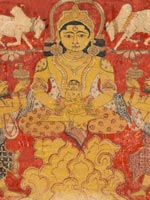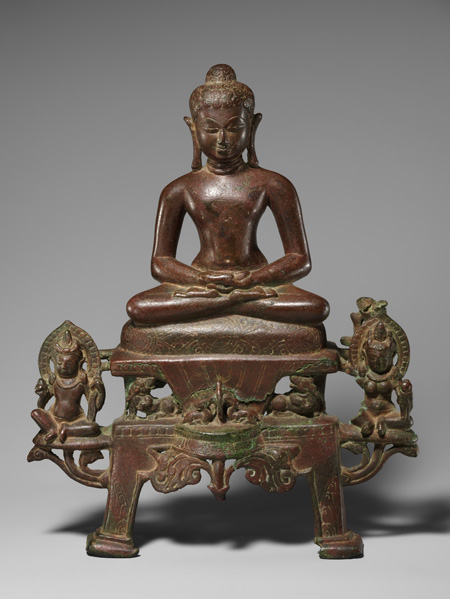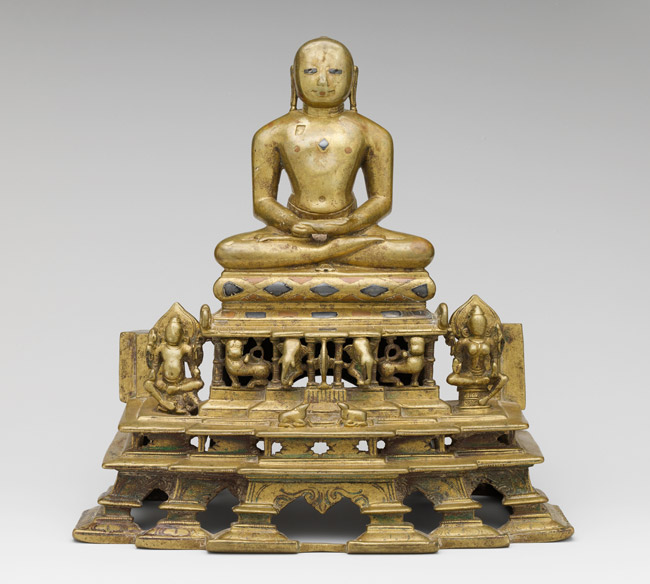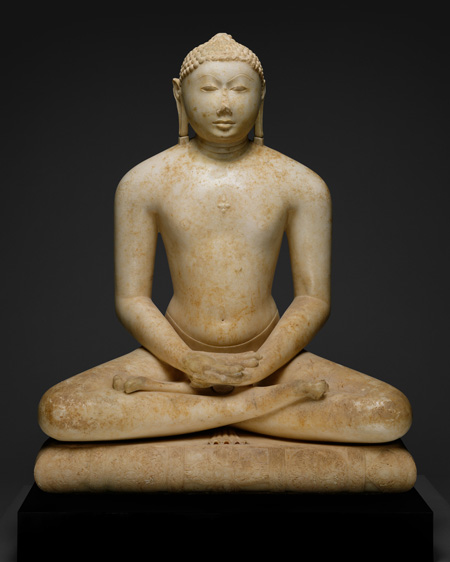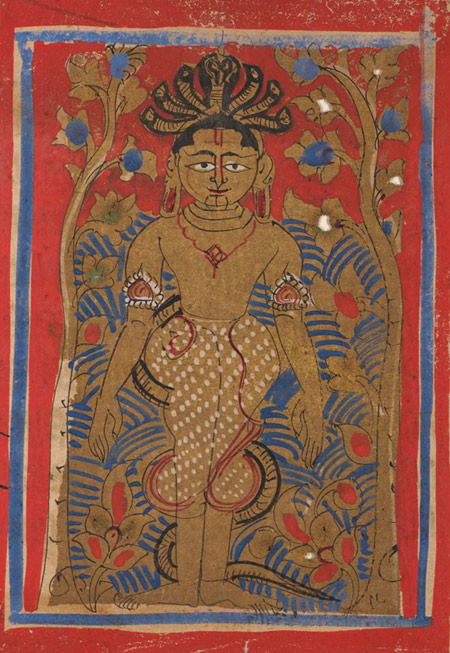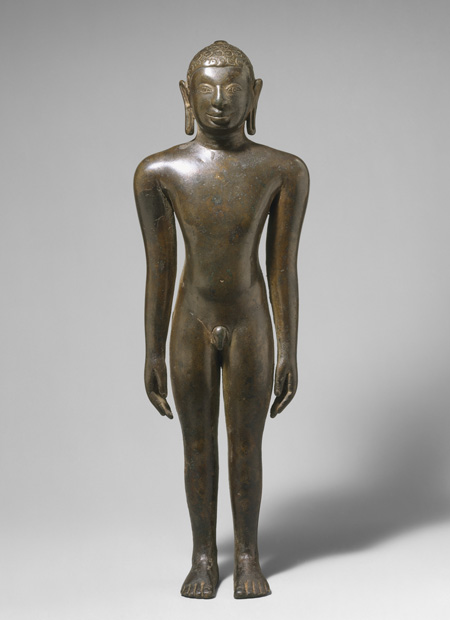
Peaceful Conquerors: Jain Manuscript Painting
September 10, 2009–March 21, 2010
Florence and Herbert Irving Galleries for the Arts of South and Southeast Asia, 3rd floor
Metropolitan Museum Of Art, NY
Jain Manuscript Paintings
| Lustration of the infant Jina Mahavira; folio from a Kalpasutra manuscript (detail), India, Gujarat, late 14th century. Opaque watercolor on paper. The Metropolitan Museum of Art, New York, Purchase, Cynthia Hazen Polsky and Leon B. Polsky Fund, 2005 (2005.35). |
The art of the book in medieval India is closely associated with the Jain religious community, and illustrated palm-leaf manuscripts survive from around the tenth century, while those on paper appear after the twelfth, when paper was introduced from Iran. The use of paper permitted larger compositions and a greater variety of decorative devices and borders. Significantly, however, the format of the palm-leaf manuscript was retained. By the end of the fourteenth century, deluxe manuscripts were produced on paper, brilliantly adorned with gold, silver, crimson, and a rich ultramarine derived from imported lapis lazuli. The patrons of the works were mainly Svetambara Jains, who considered the commissioning of illustrated books and their donation to Jain temple libraries to be an important merit-making activity. A selection of these exquisite manuscripts will be on view, along with bronzes sculptures of Jinas and a ceremonial painted textile.
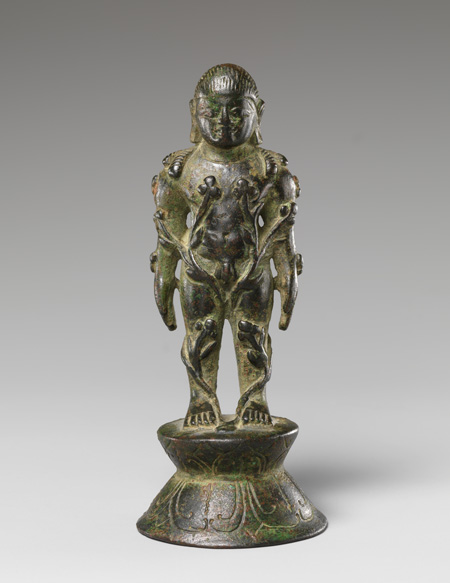
Jain Siddha Bahubali, Entwined with Forest Vines India, Karnataka, Chalukyan period, late 6th–7th century Copper alloy; H. 4 3/8 in. (11.1 cm) The Metropolitan Museum of Art, New York, Samuel Eilenberg Collection, Gift of Samuel Eilenberg, 1987 (1987.142.339) |
||
 |
||
| The oldest Jain image in the Metropolitan Museum's collection also happens to be the earliest known representation of the subject in Jain art, that of Bahubali, a prince who attained the stature of a perfected being (siddha). Although never admitted to the pantheon of twenty-four tirthankaras, he nonetheless attained jina-like status. The legend of Bahubali tells of a prince who renounces violence after coming close to slaying his brother Bharata in a battle of succession and then renounces pride and its expression—violence to other living creatures. Embracing ahimsa (nonviolence) he meditates in the "body-abandonment" posture in a forest and is entwined by vines and hosts birds that nest in his hair until he attains moksha. This diminutive icon is part of a tradition that inspired the largest rock-cut icon in the Indian subcontinent, the Bahubali at Shravana Belgola, in Karnataka, a sixty-foot-high image sculpted from living rock in the tenth century. This icon has been ritually lustrated in the mahamastakabhisheka festival every twelfth year since that time, most recently celebrated in 2006. |
Lustration of the Infant Jina Mahavira |
||
 |
||
| This painting typifies the finest achievement of the late-fourteenth-century western Indian style. It is a masterful rendering of a popular subject, the bathing of Mahavira at birth. The jina's identity is indicated by the pair of kneeling buffalo, his cognitive symbol. The infant is seated on the lap of the presiding god Shakra (Indra), and two attendant gods (further manifestations of Shakra) hold lustration vessels aloft in anticipation of his first bath (a legend shared with early Buddhism). An innovation of this period is the introduction of fantastic rocks to indicate the celestial Mount Meru—the setting for this divine abhisheka—a mannerism absorbed from Iranian paintings of the period. |
Enthroned Jina Neminatha in Meditation |
||
 |
||
| This Jain savior is meditating on a jeweled cushion atop a lion-supported throne. He has the auspicious markings (lakshanas) of an Enlightened Being, especially the ushnisha denoting sacred wisdom. He sits in a yogic posture, a pan-Indian sign of a spiritually advanced being, and before him, supported on a lotus platform, are two recumbent deer flanking a sacred wheel (dharmachakra), the latter emblematic, as in Buddhism, of sacred teachings. Projecting lotus stems support the principal attendees commonly linked to Neminatha: the yaksha Gomedha and his consort, the yakshi Ambika, supporting a standing infant. On the reverse of the base is an incomplete donor's Sanskrit inscription in seventh-century script. |
Svetambara Enthroned Jina, with Attendant Yaksha and Yakshi |
||
 |
||
| The jina is represented as a supreme yoga and acharya, an illustrious religious teacher. Elevated on a stepped, cushioned throne supported by lions and elephants, symbols of bravery and strength, this tirthankara embodies the Jain virtue of spiritual wisdom. An openwork back plate (now missing) would have evoked the heavenly palace in which he resides, accompanied by celestial adorers. His principal attendants—a seated yaksha and yakshi—flank the throne, and kneeling deer listen to the teachings symbolized by the wheel (dharmachakra) at the center of the throne pedestal. This icon was once gilded—traces can still be detected—in keeping with the desire that it emit a sacred aura like that achieved by light reflecting off gold. Indian religions have long seen the ability to absorb and radiate light as indicative of divinity. |
Jain Svetambara Tirthankara in Meditation, Seated on a Throne Cushion |
||
 |
||
| At the heart of daily Jain religious observance is the veneration of the image of the jina, the conceptual basis of which is the pan-Indian ideal of the yogic ascetic. This ancient practice, celebrated in the Vedas, equates the acquisition of superior knowledge ("spiritual wisdom") with the pursuit of advanced forms of meditation, austerities, and withdrawal from the material comforts of a householder's life. Those who attain such a state are respected and revered. In Jainism twenty-four liberated souls are recognized as having attained this level and are worshipped as the twenty-four tirthankaras, or "ford-crossers." |
Bhadrabahu (Indian, d. ca. 356 B.C.E.) |
||
 |
||
| Parsvanatha, the twenty-third jina, is shown standing in body-abandonment meditation posture (kayotsarga) in a forest, enduring a storm sent by an evil force. He receives shelter from the naga-king Dharana, who coils his snake body around the jina and provides a canopy with his seven-hooded head. This well-known story is shared with Buddhism, and we can only speculate as to which came first; certainly Jains claim that the antiquity of Parsvanatha antedates that of the Buddha by several centuries. Indeed, Parsvanatha is claimed to have lived in the sixth century B.C.E. and may well be the original founder of Jainism, rather than Mahavira, a near contemporary of the Buddha. |
Jain Digambara Tirthankara Standing in Kayotsarga Meditation Posture |
||
 |
||
| The Deccan Plateau and Tamil Nadu were strongholds of the Digambara sect, the "sky clad," or those who go naked. Jainism prospered in the south, attracting patronage from Pandyan and other rulers throughout the first millennium. Most images from that region depict jinas as fully committed renunciants, unencumbered by material possessions. Images of a tirthankara standing in the austerity meditation "body-abandonment" posture are among the most understated and beautiful of the period, and thus successfully embody the essence of the doctrine of renunciation of the material world. |
For more images please visit:
http://www.metmuseum.org/special/peaceful_conquerors/images.asp
